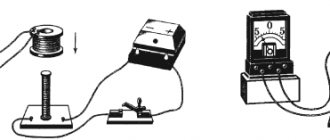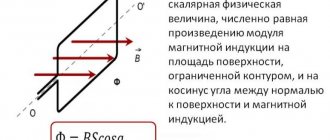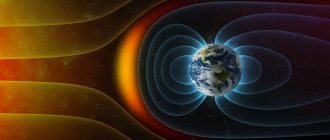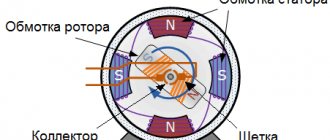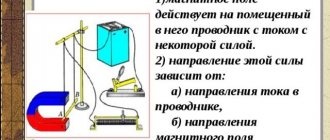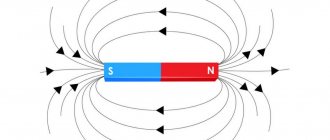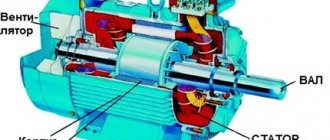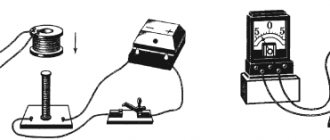The phenomenon of electromagnetic induction is what makes electric motors work and allows generators to produce electricity. It was its discovery at the beginning of the 19th century that led to the active development of such industries as energy, machine tool building, and transport. This phenomenon is also widely used in medicine, radio broadcasting, and in the production of flow meters - electricity meters.
Practical meaning of electromagnetic induction
The essence of this phenomenon, when and who discovered it, what inductance and self-induction are, what energy characterizes a set of magnetic lines of force will be discussed in this article.
The phenomenon of electromagnetic induction
The classic definition of this phenomenon states that it is the appearance of the ordered movement of charged particles in a closed current-carrying circuit (conductor) when the set of magnetic force lines passing through it, created by a permanent magnet, changes.
On a note. The phenomenon described in the article was first discovered experimentally in 1831 by the famous physicist Michael Faraday. For his experiments, he used an iron ring with turns of copper wire wound on two opposite sides, which were connected to a galvanic element and a magnetic needle. When a galvanic element was connected to the first winding, the needle moved for some time, then stopped; after it was turned off, it smoothly returned to its original position. Such movements of the arrow suggested that the ordered movement of electric charge carriers can arise under the influence of a set of magnetic force lines, the source of which is the first winding.
Michael Faraday
Discovery of electromagnetic induction
After Oersted's
and
Ampere
it became clear that electricity has magnetic force. Now it was necessary to confirm the influence of magnetic phenomena on electrical ones. Faraday brilliantly solved this problem.
Michael Faraday (1791-1867) was born in London, in one of its poorest parts. His father was a blacksmith, and his mother was the daughter of a tenant farmer. When Faraday reached school age, he was sent to primary school. The course Faraday took here was very narrow and was limited only to learning to read, write and begin to count.
A few steps from the house in which the Faraday family lived, there was a bookshop, which was also a bookbinding establishment. This is where Faraday ended up, having completed his primary school course, when the question arose about choosing a profession for him. Michael was only 13 years old at this time. Already in his youth, when Faraday was just beginning his self-education, he sought to rely exclusively on facts and verify the messages of others with his own experiences.
These aspirations dominated him all his life as the main features of his scientific activity. Faraday began to carry out physical and chemical experiments as a boy at his first acquaintance with physics and chemistry. Michael once attended one of Humphry Davy's
, the great English physicist.
Faraday made a detailed note of the lecture, bound it and sent it to Davy. He was so impressed that he invited Faraday to work with him as a secretary. Soon Davy went on a trip to Europe and took Faraday with him. Over the course of two years, they visited the largest European universities.
Returning to London in 1815, Faraday began working as an assistant in one of the laboratories of the Royal Institution in London. At that time it was one of the best physics laboratories in the world. From 1816 to 1818, Faraday published a number of small notes and short memoirs on chemistry. Faraday's first work on physics dates back to 1818.
Based on the experiences of his predecessors and combining several of his own experiences, by September 1821 Michael published “The History of the Advances of Electromagnetism”
. Already at this time, he formed a completely correct concept of the essence of the phenomenon of deflection of a magnetic needle under the influence of current.
Having achieved this success, Faraday left his studies in the field of electricity for ten years, devoting himself to the study of a number of subjects of a different kind. In 1823, Faraday made one of the most important discoveries in the field of physics - he was the first to liquefy gas, and at the same time established a simple but effective method for converting gases into liquid. In 1824, Faraday made several discoveries in the field of physics.
Among other things, he established the fact that light affects the color of glass, changing it. The following year, Faraday again turned from physics to chemistry, and the result of his work in this area was the discovery of gasoline and sulfur-naphthalene acid.
In 1831, Faraday published a treatise “On a Special Kind of Optical Illusion,” which served as the basis for an excellent and curious optical projectile called the “chromotrope.” In the same year, another treatise by the scientist, “On Vibrating Plates,” was published. Many of these works could themselves immortalize the name of their author. But the most important of Faraday's scientific works are his research in the field of electromagnetism and electrical induction.
.
Strictly speaking, an important branch of physics that treats the phenomena of electromagnetism and inductive electricity, and which is currently of such enormous importance for technology, was created by Faraday out of nothing.
By the time Faraday finally devoted himself to research in the field of electricity, it was established that under ordinary conditions the presence of an electrified body is sufficient for its influence to excite electricity in any other body. At the same time, it was known that a wire through which current passes and which also represents an electrified body does not have any effect on other wires placed nearby.
What caused this exception? This is the question that interested Faraday and the solution of which led him to the most important discoveries in the field of induction electricity. As was his custom, Faraday began a series of experiments designed to clarify the essence of the matter.
Faraday wound two insulated wires parallel to each other on the same wooden rolling pin. He connected the ends of one wire to a battery of ten cells, and the ends of the other to a sensitive galvanometer. When current was passed through the first wire,
Faraday turned all his attention to the galvanometer, expecting to notice from its vibrations the appearance of a current in the second wire. However, nothing of the kind happened: the galvanometer remained calm. Faraday decided to increase the current strength and introduced 120 galvanic elements into the circuit. The result was the same. Faraday repeated this experiment dozens of times and still with the same success.
Anyone else in his place would have left the experiments convinced that the current passing through a wire has no effect on the neighboring wire. But Faraday always tried to extract from his experiments and observations everything that they could give, and therefore, not receiving a direct effect on the wire connected to the galvanometer, he began to look for side effects.
He immediately noticed that the galvanometer, remaining completely calm during the entire passage of current, begins to oscillate when the circuit itself is closed and when it is opened. It turned out that at the moment when a current is passed into the first wire, and also when this transmission stops, at the second wire is also excited by a current, which in the first case has the opposite direction to the first current and the same with it in the second case and lasts only one instant.
These secondary instantaneous currents, caused by the influence of the primary ones, were called inductive by Faraday, and this name has remained with them to this day. Being instantaneous, instantly disappearing after their appearance, inductive currents would have no practical significance if Faraday had not found a way, with the help of an ingenious device (a commutator), to constantly interrupt and re-conduct the primary current coming from the battery along the first wire, thanks to which the second wire is continuously excited by more and more new inductive currents, thus becoming constant. Thus, a new source of electrical energy was found, in addition to the previously known ones (friction and chemical processes), - induction, and a new type of this energy - inductive electricity
.
Continuing his experiments, Faraday further discovered that simply bringing a wire twisted into a closed curve close to another through which a galvanic current flows is sufficient to excite an inductive current in the neutral wire in the direction opposite to the galvanic current, and that removing the neutral wire again excites an inductive current in it. the current is already in the same direction as the galvanic current flowing along a stationary wire, and that, finally, these inductive currents are excited only during the approach and removal of the wire to the conductor of the galvanic current, and without this movement the currents are not excited, no matter how close the wires are to each other .
Thus, a new phenomenon was discovered, similar to the above-described phenomenon of induction when the galvanic current closes and stops. These discoveries in turn gave rise to new ones. If it is possible to cause an inductive current by short-circuiting and stopping the galvanic current, then wouldn’t the same result be obtained by magnetizing and demagnetizing iron?
The work of Oersted and Ampere had already established the relationship between magnetism and electricity. It was known that iron becomes a magnet when an insulated wire is wound around it and a galvanic current passes through it, and that the magnetic properties of this iron cease as soon as the current stops.
Based on this, Faraday came up with this kind of experiment: two insulated wires were wound around an iron ring; with one wire wrapped around one half of the ring, and the other around the other. Current from a galvanic battery was passed through one wire, and the ends of the other were connected to a galvanometer. And so, when the current closed or stopped and when, consequently, the iron ring was magnetized or demagnetized, the galvanometer needle quickly oscillated and then quickly stopped, that is, the same instantaneous inductive currents were excited in the neutral wire - this time: already under the influence of magnetism.
Thus, here for the first time magnetism was converted into electricity. Having received these results, Faraday decided to diversify his experiments. Instead of an iron ring, he began to use an iron strip. Instead of exciting magnetism in iron by galvanic current, he magnetized the iron by touching it to a permanent steel magnet. The result was the same: always in the wire wrapped around the iron! a current was excited at the moment of magnetization and demagnetization of iron.
Then Faraday introduced a steel magnet into the wire spiral - the approach and removal of the latter caused induced currents in the wire. In a word, magnetism, in the sense of exciting induction currents, acted in exactly the same way as galvanic current.
Magnetic flux
Corrugated pipe
This phenomenon, magnetic flux, is a set of lines of force passing through a certain cross-section of a conductor or a closed conductive circuit.
The module of this quantity Ф is calculated using the following formula:
Ф= B×S×Cos α, where:
- B is the module of the vector of induction created by the power lines;
- S is the surface area through which the flow of field lines passes;
- α – the angle between the vectors of the induction lines of force and the normal (i.e., perpendicular to the plane pierced by the magnetic lines of force).
This value is measured in Webers (Wb).
Faraday's law of electromagnetic induction
Resistor power
This fundamental law has the following formulation: with any changes in the magnetic flux passing through the conducting circuit, an electromotive force (abbreviated EMF) occurs, the value of which is directly proportional to the speed at which the magnetic flux changes.
This pattern is reflected in the following formula:
Ɛi = – ΔФ/Δt, where:
- Ɛi – electromotive force of induction appearing in the current-carrying circuit;
- ΔФ/Δt – the speed at which the magnetic flux passing through a closed loop changes.
Thus, the strength of the induction current formed in a conductive closed circuit when exposed to an electromotive force will depend on the speed at which the flow of the magnetic field lines passing through it changes.
Vector shape
In vector form, this law is expressed by the following formula:
rot E= ΔB/Δt.
According to this notation, the electric field strength (E) of the induced current increases as the rate of change of flux B increases with the field lines crossing the closed loop.
Potential form
Using a vector potential, the law of electromagnetic induction has the following entry:
E =ΔA/Δt , where:
- E – electric field strength generated by the induction current;
- ΔA/Δt – change in the vector potential of the magnetic field passing through a closed loop, which is part of a closed conductor circuit.
Law of Electromagnetic Induction
M. Faraday conducted numerous experiments, recording the results, and from these experimental tables of electromagnetic induction he established that a current in a conducting circuit arises only when the magnetic field penetrating this circuit changes.
To quantitatively describe this phenomenon, the concept of magnetic flux is used. If induction characterizes the strength of the magnetic field at a point, then magnetic flux characterizes the density of magnetic induction lines. The magnetic flux through a circuit of area S is equal to the product of the induction module B by the area S and by the cosine of the angle between the induction vector and the normal to the circuit:
$$Ф=BScosα$$
Rice. 3. Ф=BScosa.
The phenomenon of electromagnetic induction is that when the magnetic flux through the circuit changes by an amount ΔФ over time Δt, external forces arise in it, creating a potential difference called EMF (electromotive force):
$$ε= -{ΔФ\over Δt}$$
The minus sign in this formula of electromagnetic induction means that the resulting EMF, in accordance with E. Lenz’s rule, is directed so as to create a current that counteracts the cause that created it.
Interaction of a magnet with a circuit
As a clear example of the interaction between a magnet and a circuit, a magnet is placed in a coil made of copper wire. If a magnet is slowly inserted into the coil, the flux created by the magnet across its turns gradually increases. The ordered movement of particles in the coil that appears as a result of such manipulation will be directed clockwise, creating its own magnetic field that weakens the field of the magnet, thereby repelling it from the coil.
If the magnet is moved away from the circuit, its flux decreases, and charged particles begin to move counterclockwise, as a result of which the resulting set of magnetic force lines will attract the magnet.
On a note. In the case of an open (open) circuit: a metal or aluminum ring with a slot; coil, the turns of which are not closed through the ammeter, the power source, this pattern, like Lenz’s rule, does not work.
Experiment with coil and magnet
The interaction of a moving magnet and a coil wound from a conductor generates an electric current. The magnet must move in this case. The mere presence of a stationary magnet near a coil does not produce electric current. Moreover, when a magnet is inserted into a coil, an electric current of one direction appears in the circuit (the galvanometer needle deviates, for example, to the right); When the magnet is removed from the coil, the arrow deflects in the opposite direction. Thus, the nature of the current depends on the speed and direction of movement of the magnet, as well as on which pole it is inserted into the coil.
Are you an expert in this subject area? We invite you to become the author of the Directory Working Conditions
The current arising when a magnet moves inside or near a coil is called induction (homing).
Faraday's observations of the interaction of a magnet and a coil with a conductor laid the foundation for modern electrical engineering. Modern DC electric motors operate on this principle (see example below).
Vortex electric field
A magnetic field varying in time and space is the source of the appearance of a vortex electric field with closed lines of force. Its effect explains the ordered movement of unit charges in a conductor in a (static) stationary state.
The direction of the electric field lines obeys the Lenz rule and the “gimlet” rule.
Vortex lines of force
Electromagnetic induction
So far we have considered electric and magnetic fields that do not change over time. It was found that the electrostatic field is created by stationary charged particles, and the magnetic field by moving ones, i.e., electric current. Now let's get acquainted with electric and magnetic fields, which change over time.
The most important fact that was discovered is the close relationship between electric and magnetic fields. It turned out that a time-varying magnetic field generates an electric field, and a changing electric field generates a magnetic field. Without this connection between fields, the variety of manifestations of electromagnetic forces would not be as extensive as they actually are. There would be no radio waves or light.
Inductance
Passing along the circuit, the electric current contributes to the formation of a set of magnetic lines of force around it. According to the formula Ф = L×I, the flux Ф created by the magnet depends proportionally on the current strength I.
Thus, inductance L is understood as the coefficient of the ratio between the magnetic flux Ф and the current I flowing through the circuit. This value is calculated using the following formula:
L=F/I.
The unit of measurement for this physical quantity is Henry (H). 1 H is the inductance formed in a closed circuit in which the current changes by 1 Ampere, and the voltage in it is 1 Volt.
Determination of the sign of the induced emf
The figure shows a closed contour. We will consider the direction of traversing the circuit counterclockwise to be positive. The normal →n to the contour forms a right screw with the direction of the bypass.
Let the magnetic induction →B of the external magnetic field be directed along the normal to the contour and increase with time. Then Φ>0 and ΔΦΔt..>0. According to Lenz's rule, the induced current creates a magnetic flux Φ'<0. The magnetic induction lines B' of the magnetic field of the induced current are shown in black. Consequently, the induced current Ii according to the gimlet rule is directed clockwise (against the direction of the positive circuit) and the induced emf is negative. Therefore, in the law of electromagnetic induction there should be a “–” sign, indicating that εi and ΔΦΔt.. have different signs:
εi=−ΔΦΔt..
Example No. 1. The magnetic flux through a conductor circuit with a resistance of 3∙10–2 Ohm changed to 1.2∙10–2 Wb in 2 s. Find the current strength in the conductor if the flux changes uniformly.
It is known that:
Ii=εiR..
εi=∣∣∣ΔΦΔt..∣∣∣
Hence:
Magnetic field energy
The set of magnetic lines of force has a certain amount of energy. Since this phenomenon in the circuit is caused by the flow of electric current through it, the amount of such energy depends on the amount of expenditure of sources (generators, galvanic cells) to create the current. This value (Wmag.p) is calculated using the following mathematical formula:
Wmag.p= (L×I2)/2.
On a note. From a practical point of view, the value of this value affects the power of electrical units: electric motors, generators. The greater the power of the power lines formed by the windings or permanent magnets of the stator and rotor, the higher the torque and power of the engine, the greater its efficiency.
Basic formulas
The basic formulas for the phenomenon of magnetic induction are shown in the figure below.
Basic formulas describing the phenomenon of electromagnetic induction
Having understood the essence of the phenomenon of electromagnetic induction, you can understand how electric motors and generators work. This knowledge, in addition to its great theoretical value, has quite a useful practical application, allowing you to independently find, and in some cases eliminate, unit malfunctions without resorting to the expensive services of specialists.
Application of electromagnetic induction
This phenomenon is actively used in various spheres of human society.
Below are some of the most famous examples:
- radio broadcasting is impossible without using the phenomenon of electromagnetic induction;
- in medicine, magnetic therapy is one of the effective treatment methods;
- in fundamental research, synchrophasotrons are used to accelerate elementary particles, the operation of which is based on the phenomenon of inductance;
- electricity meters used in everyday life to account for electricity use the phenomenon under consideration;
- in order to transmit electrical energy produced by power plants over long distances, transformers are used, the operation of which is based on the use of electromagnetic induction;
- In metallurgy, induction furnaces are used to melt metal.
The use of this phenomenon is very widespread. The examples given are just a sampling of the various use cases.
